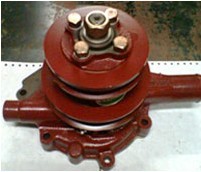Early car engines did not have the important accessory pumps that we deemed necessary today. The liquid cooling medium used was pure water, with a little wood alcohol added at the time to prevent ice formation. The circulation of cooling water depends entirely on the natural phenomenon of thermal convection. After the cooling water absorbs heat from the cylinder block, it naturally flows upwards and enters the upper part of the radiator. After the cooling water becomes cold, it naturally sinks to the bottom of the radiator and enters the lower part of the cylinder block. Using this thermosyphon principle can barely complete the cooling task. But soon after, a water pump was added to the cooling system to allow the cooling water to flow more quickly.

Today's automotive engine cooling systems generally use centrifugal pumps. The most reasonable installation location of the pumps is at the bottom of the cooling system, but most of the pumps are located in the middle of the cooling system, and a small number of pumps are placed on the top of the engine. Pumps placed on top of the engine are prone to cavitation. No matter what the position, the water pump pump is very large. For example, the pump capacity of a V8 engine is approximately 750 L/h at idle and approximately 12,000 L/h at high speed.
Troubleshooting
Although the durability of the car has been greatly improved, the water pump still needs a lot of replacement work. After the car has traveled for about 100,000 kilometers, the water pump may malfunction at any time.
Fault diagnosis of pumps is generally relatively simple. In the case of a leak in the cooling system, the smell of hot antifreeze can be smelled, but a check must be made to find out if the cooling water is leaking from the shaft seal. A small mirror and light can be used to see if there is water leakage at the vent hole of the pump. Carry out maintenance on a regular basis and pay attention to checking the coolant coolant loss.
Leakage is the number one fault of the pump, noise is the second fault, and the phenomenon of water pump shaft seizing due to abrasion of the bearing is very rare. Once this happens, the wind and the radiator can be damaged.
Although in the literature on vehicle maintenance, it is often seen that the pump impeller is severely corroded. However, if normal maintenance is performed, impeller erosion is not a common phenomenon. When you see the red color of the coolant and the rust color, it is estimated that there is a problem of corrosion of the impeller. At this time, it is necessary to check the circulating conditions of the coolant of the water pump. A portion of the coolant in the radiator can be released, so that the water level can be maintained at the top of the water pipe. Then the engine is warmed up and the thermostat is in the fully open position. When the engine speed is 3000r/min, good water circulation should be seen. Another possible problem is the loosening of the pump impeller on the shaft.

The cause of the failure
As for the cause of the failure of the water pump, it is generally considered that more and more accessories are driven by the same belt and the lateral load is excessively large. Evidence shows that the resonance generated by the accessories driven by the same belt has different frequencies and can damage the seal of the pump.
Another problem with pump failures is that the serpentine belt tensioner exerts a large lateral load on the pump. Cavitation is another problem with water pumps. Generally corrosion occurs on the water inlet side of the pump, so a low pressure radiator cover is usually installed. When replacing the pump, it is advisable to install a new fan clutch, as the unbalanced clutch may cause problems with the pump.
Others believe that overheating and lack of maintenance are also the cause of problems with the pumps. If the coolant loses its ability to lubricate the seal, the seal will be scratched. In addition, the failure of the pump may also be due to the poor quality of the pump itself.




